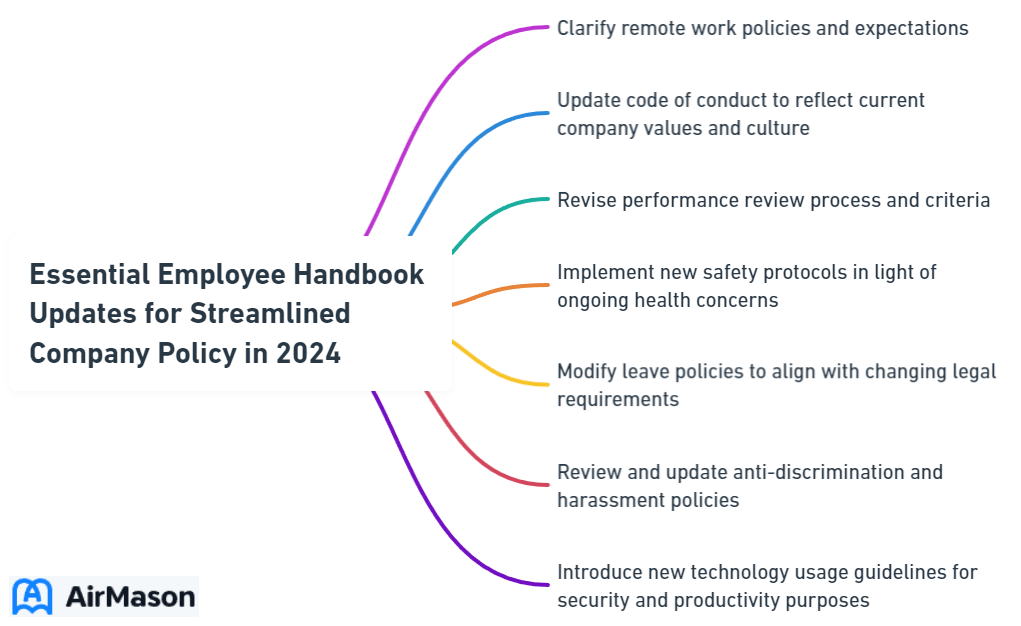
Are you navigating the 2024 shifts in employment law? Critical employee handbook updates, from addressing reproductive loss leave to finessing flexible sick leave and off-duty cannabis use policies, are non-negotiable. This guide provides the essentials, ensuring your employee handbook remains a reliable beacon for your staff and a bastion of compliance for your company. Let’s dive into the updates that require your immediate attention.
Key Takeaways
- Updating the employee handbook with key 2024 federal laws and policies influences various aspects such as reproductive loss leave, expanded sick leave policies, off-duty cannabis use, and compliance with the National Labor Relations Act.
- Customization of the employee handbook is crucial to address the unique needs and culture of the company. This includes leveraging technology for accessibility, integrating COVID-19 policies and remote work guidelines, as well as focusing on diversity and inclusion initiatives.
- Maintaining an up-to-date employee handbook is central to legal compliance and conflict mitigation, requiring regular monitoring of legal changes, incorporating employee feedback, and following best practices such as regular audits, legal review, and providing training and education.
Employee Handbook Changes
Employee Handbook Changes signify updates and modifications to the established guidelines and policies governing the conduct and responsibilities of employees within an organization. These alterations can range from minor adjustments to significant revisions aimed at aligning the handbook with evolving legal regulations, industry standards, or internal processes. It’s essential for employees to stay informed about these changes to ensure compliance and understanding of their rights and obligations within the workplace. Clear communication channels should be established to disseminate these updates effectively, whether through email notifications, staff meetings, or dedicated training sessions. Furthermore, soliciting feedback from employees regarding proposed changes can foster a sense of inclusivity and engagement, potentially leading to smoother transitions and greater acceptance of the updated policies
Key 2024 Employee Handbook Updates

2024 has ushered in new federal laws and employment laws that necessitate significant revisions to your employee handbook. These updates encompass pivotal areas such as:
- Reproductive loss leave
- Expanded sick leave policies
- Provisions for off-duty cannabis use
- Compliance with changes in the National Labor Relations Act
Updating the employee handbook is a key priority for employers to ensure that employees understand their rights and responsibilities, and that the company stays on the right side of the law. By addressing employee expectations in the handbook, employers can create a more transparent and harmonious workplace.
A thoroughly updated employee handbook sets clear guidelines for employee conduct and performance, outlines rights, and conveys legal responsibilities. It plays a crucial role in fostering a healthy work environment and preventing employment discrimination. Now, let’s explore these major 2024 handbook updates and their impact on your company policies.
Reproductive Loss Leave
The introduction of the Reproductive Loss Leave law has significant implications for your employee handbook. This law, which took effect on January 1, 2024, necessitates the incorporation of up to five days of leave for employees who experience reproductive loss events such as a failed adoption or unsuccessful assisted reproduction.
This major legislative change, the Medical Leave Act, necessitates your company’s establishment of a distinct leave category dedicated to reproductive loss if you have five or more employees. Consequently, it’s of utmost importance to update your handbook to enlighten employees about their rights and entitlements under this new regulation.

Expanded Sick Leave Requirements
Another key change in 2024 is the expansion of paid sick leave requirements. This new law, in effect from January 1, 2024, mandates employers to increase the sick leave entitlement for employees from three days/24 hours to five days/40 hours. Furthermore, businesses now have the authority to restrict employees’ sick leave to 40 hours and set a cap on the accumulation of leave at 80 hours, or 10 days.
This shift in employment policies needs clear articulation in your updated employee handbook. An increase in the annual accrual cap from 6 to 10 days not only ensures your company’s legal compliance but also equips employees with ample time to recover when they are unwell.
Off Duty Cannabis Use and Drug Testing
The evolving legal landscape around cannabis use has also brought changes to the employee handbook. In certain states, off-duty recreational use of cannabis is protected, preventing employers from taking adverse action based solely on a positive drug test result. However, there are exceptions for certain job positions or under specific conditions, such as ‘safety-sensitive’ job positions where impairment could pose significant safety risks.
It’s essential to revise your handbook, clearly outlining your company’s position on off-duty cannabis use and the implications it holds for drug testing policies.
National Labor Relations Act Compliance
Lastly, the National Labor Relations Act (NLRA) has introduced new regulations that necessitate updates to your employee handbook. The NLRA safeguards employees’ rights to discuss their wages, strive for improved working conditions, and partake in other coordinated activities for mutual aid or protection.
To ensure compliance with the NLRA, you should review and revise your company policies pertaining to employees’ rights. This includes updating your policies on employee conduct, confidentiality, and social media usage to ensure they don’t impede or restrict employees in the exercise of their rights as stipulated by the NLRA.
Customizing Your Employee Handbook

While it’s important to update your employee handbook in accordance with new laws, customizing it to fit your company’s unique needs and culture is equally significant. By leveraging technology, addressing diversity and inclusion initiatives, and incorporating COVID-19 policies and remote work guidelines, you can create a handbook that not only ensures legal compliance but also resonates with your employees.
However, there’s no one-size-fits-all method to customizing your employee handbook. It demands a deep understanding of your company’s culture and employees’ needs. In the subsequent sections, we’ll explore effective ways to tailor your handbook, ensuring its continued relevance and usefulness for your employees.
Leverage Technology for Accessibility
The digital revolution has transformed the way we work, and it’s high time that employee handbooks caught up. By leveraging technology, you can enhance the accessibility of your handbook, making it more engaging and user-friendly for your employees.
You can incorporate engaging visuals, launch a user-friendly mobile app, or even use an HR chatbot to share resources. Digital tools such as FlipHTML5 and Visme can be used to enhance the interactivity of your handbook, making it easier for employees to find specific information.
By utilizing technology, you can ensure your handbook is easily accessible and comprehensible to all employees.
Include COVID-19 Policies and Remote Work Guidelines
The COVID-19 pandemic has reshaped the world of work, and your employee handbook needs to reflect this new reality. This includes integrating COVID-19 safety protocols, and specific guidance for on-site work, especially for individuals who have been unwell or are exhibiting symptoms.
Additionally, with the rise in remote work, it becomes vital to incorporate distinct remote work guidelines in your handbook. This should encompass:
- Specifying expectations for availability and communication
- Reiterating the application of all company rules to remote workers
- Providing precise instructions on remote work arrangements
Handbooks Online
Handbooks Online offers a comprehensive repository of digital resources, catering to diverse interests and needs. Whether you seek guidance in academic subjects, professional development, or personal hobbies, Handbooks Online provides accessible and reliable information at your fingertips. With an extensive collection spanning various disciplines and topics, users can easily navigate through the platform to find the resources they require. From tutorials and manuals to in-depth analyses and reference materials, Handbooks Online strives to empower learners and enthusiasts alike with valuable knowledge. Explore the vast array of handbooks available and enrich your understanding in the subjects that matter to you.
Address Diversity and Inclusion Initiatives
Diversity and inclusion are more than mere buzzwords – they are the foundation of a truly inclusive workplace. Your employee handbook should reflect your company’s commitment to these values by incorporating a policy that upholds diversity and inclusion principles.
In addition, consider enhancing the introduction of your handbook with a diversity statement or approach that reflects your company’s commitment to creating an inclusive work environment. This way, every employee, regardless of their background or identity, can feel valued and welcomed in your organization.
Maintaining Legal Compliance and Mitigating Conflicts

Regular updates to your employee handbook go beyond merely adding new policies or reflecting organizational changes. They also play a crucial role in maintaining legal compliance and reducing conflicts. By monitoring legal changes and involving employees in the updating process, you can ensure that your handbook remains compliant and minimizes potential conflicts.
However, the dual task of maintaining legal compliance and minimizing legal risks isn’t a one-off endeavor. It demands continuous efforts, periodic audits, and transparent communication.
In the next sections, we’ll delve deeper into how you can maintain legal compliance and mitigate conflicts when updating your handbook.
Regular Monitoring of Legal Changes
Staying up-to-date with legal changes is crucial for maintaining compliance. You should review all policies and procedures regularly, stay informed about changes in labor laws, and engage with relevant HR organizations.
Regular audits should be carried out at least once a year, and ideally every two years in partnership with an employment attorney. This helps to:
- Guarantee compliance with employment laws
- Maintain the relevance and currency of the handbook
- Safeguard against allegations of improper employer behavior.
Employee Input and Feedback
Employee input and feedback are invaluable resources when updating your employee handbook. Employees are the ones who interact with policies on a daily basis, and their insights can help ensure that the handbook accurately represents the genuine needs and concerns of the team.
By involving employees in the process, you not only foster a positive work environment but also promote better understanding, adherence to policies, and a heightened sense of ownership. Regular surveys, feedback sessions, and stay interviews are just some of the methods you can use to gather and assess employee input. This approach contributes to effective employee engagement.
Best Practices for Updating Employee Handbooks

The significant task of updating your employee handbook can be made smoother and more efficient with a set of best practices to guide you. Regular audits, seeking legal review, and providing training and education are just a few of these best practices that can help ensure your handbook remains up-to-date and compliant.
But putting these practices into action requires careful planning and implementation. In the following sections, we’ll delve deeper into each of these practices and provide you with practical tips and advice to make your handbook updating process as effective as possible.
Conduct Regular Audits
Regular audits are a vital part of maintaining an up-to-date and compliant employee handbook. By reviewing your handbook at least annually, you can ensure that it accurately represents current practice policies, legal regulations, and societal changes.
During the audit, you should prioritize areas such as:
- Wage policies
- Leave benefits
- Conduct and other general requirements
- HR policies and procedures
This will help you identify and address any discrepancies between the policies stated in the handbook and the actual practices of the company.
Seek Legal Review
Seeking legal review is another essential step in the handbook updating process. It involves consulting with specialized employment lawyers who can ensure that your handbook is legally sound and compliant.
Remember, failure to have your handbook reviewed by a lawyer can result in legal non-compliance, potential liability exposure, and misinterpretation of policies in the event of employee lawsuits. Therefore, it’s crucial to seek and select a reliable employment lawyer who has experience in reviewing employee handbooks.
Provide Training and Education
Last but not least, providing regular training and education sessions is key to ensuring employees understand and comply with updated policies. Training should be conducted at least once per year, using platforms such as EdApp, Livestorm, and Teachfloor for virtual sessions.
Remember, the goal of training is not just to inform employees about the changes but also to measure their understanding and the effectiveness of the training. Therefore, you should also set up mechanisms to assess the efficacy of your training sessions.
Implementing New Policies and Procedures

Upon finalizing your updated handbook, the last step is to put the new policies and procedures into action. This may sound straightforward, but it requires careful planning and communication to ensure a smooth transition and employee understanding.
In the following sections, we’ll discuss how to communicate changes effectively and align new policies with your company culture. These steps will help ensure that your updated handbook is not just legally compliant, but also resonates with your employees and fosters a positive work environment.
Communicate Changes Effectively
Effective communication is key to successful policy implementation. To communicate changes effectively, you should use clear language, visual aids, and regular updates. Remember, the goal is not just to inform employees about the changes, but also to ensure they understand and are able to comply with the new policies.
You can utilize different communication channels to disseminate updates, including email, staff meetings, and intranet posts. Remember, the more methods you use to communicate the changes, the more likely it is that your message will reach all employees and be understood.
Align with Company Culture
Finally, it’s important to confirm that your new policies are in alignment with your company culture. This not only helps ensure acceptance by the workforce but also helps reflect your organization’s values and beliefs.
To do this, you should:
- Understand your company’s culture
- Assess existing policies
- Involve employees in the process
- Communicate effectively
By aligning your new policies with your company culture, you can foster a positive work environment that promotes adherence to the policies and guarantees that they uphold the company’s core values.
Summary
In conclusion, regularly updating your employee handbook is a vital task that requires careful planning, regular audits, and effective communication. By staying abreast of legal changes, involving employees in the process, and aligning new policies with your company culture, you can create a handbook that not only complies with the law but also resonates with your employees. Remember, your employee handbook is more than just a list of rules – it’s a reflection of your company’s mission, values, and culture. So take the time to update it regularly, and ensure it remains a valuable resource for your employees.
Frequently Asked Questions
How often should an employee handbook be updated?
It is recommended to review and update the employee handbook at least once a year to ensure accuracy and compliance with changing employment laws and regulations.
How do I notify employees of handbook updates?
Notify your employees of handbook updates by dating the updated version, distributing it electronically to all employees, highlighting the changes, and asking them to re-read the document and sign an acknowledgement form. This approach ensures employees are informed about updates and acknowledges their receipt.
How do you announce a new employee handbook?
When announcing a new employee handbook, it is important to be clear and transparent in your communication. Clearly state the reason for the change and explain the potential benefits to the employees.
How often should policy manuals be updated?
Policy manuals should be reviewed every year to ensure they are up to date and compliant with current standards and regulations.
How can I make my employee handbook more engaging and accessible?
You can make your employee handbook more engaging and accessible by leveraging technology such as digital tools and visual aids.
Important Disclaimer:
Please be aware that the content on this page has been generated by using artificial intelligence language models and may contain errors, inconsistencies, or outdated information. It is provided as-is without any warranties or guarantees of accuracy.
We strongly recommend using this content as a starting point for further research. We disclaim any liability for damages or losses resulting from the use or reliance on this content.